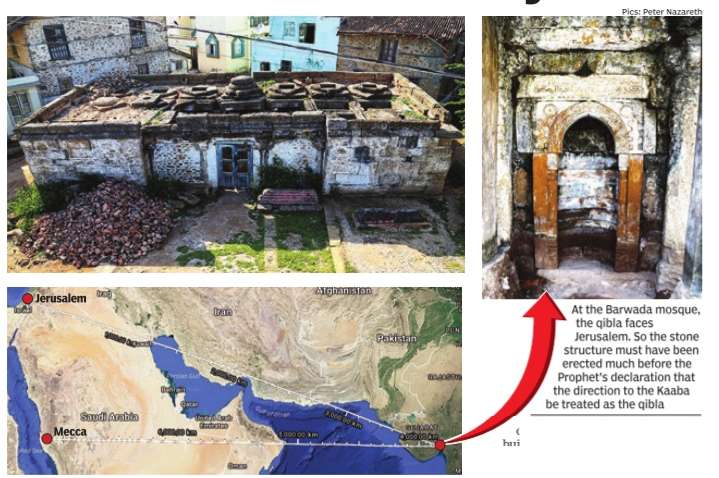

The Juni Masjid or Barwada Masjid, on the northern edge of the ancient port town of Ghogha, on the Gulf of Khambhat, is still in its original form, albeit in a dilapidated condition. Like the Cheraman mosque, the Barwada mosque (Barwada Masjid in Gujarati translates as outsiders' or foreigners' mosque) is not a listed monument and is not covered by any conservation plan. No information is available on when it was built and who built it, but some historians contend that it predates the Cheraman Mosque, which was built in AD 629, and the Palaiya Jumma Palli, or The Old Jumma Masjid of Kilakaria in Tamil Nadu, which was constructed between AD 628 and 630. The reason to consider this 15x40 foot structure as the oldest mosque in India lies in the Muslim custom of offering namaz during the times of Prophet Muhammad. One tradition says that Muslims prayed to face `Baitul Muqaddas' in Jerusalem for the first 13 years of Islam ¬ from AD 610 to 623. Another tradition limits the period of maintaining the qibla -the direction Muslims face during salat -towards Jerusalem to the 17 months after the Hijra, the Prophet's exodus from Mecca to Medina. In AD 623, while offering namaz in Medina, Muhammad had a revelation and declared that Muslims were to face the Kaaba during prayers. From then on, Muslims stopped facing Jerusalem, and the qibla has faced the Kaaba. At the Barwada mosque in Ghogha, the qibla, indicated by the position of the mihrab (a semi-circular niche in the wall facing which prayers are offered), is towards Jerusalem, an angle nearly 20 degrees north of the qibla towards Mecca. This reflects the fact that this stone structure must have been erected much before the Prophet's declaration that the direction to the Kaaba be treated as the qibla. The historical mosques in Kerala and Tamil Nadu have their qibla towards the Kaaba. Compass readings taken at the site put the heading of the mihrab from the entrance at about 295°NW. As at a newer mosque in the same neighborhood, the heading towards the Kaaba is about 275°NW.